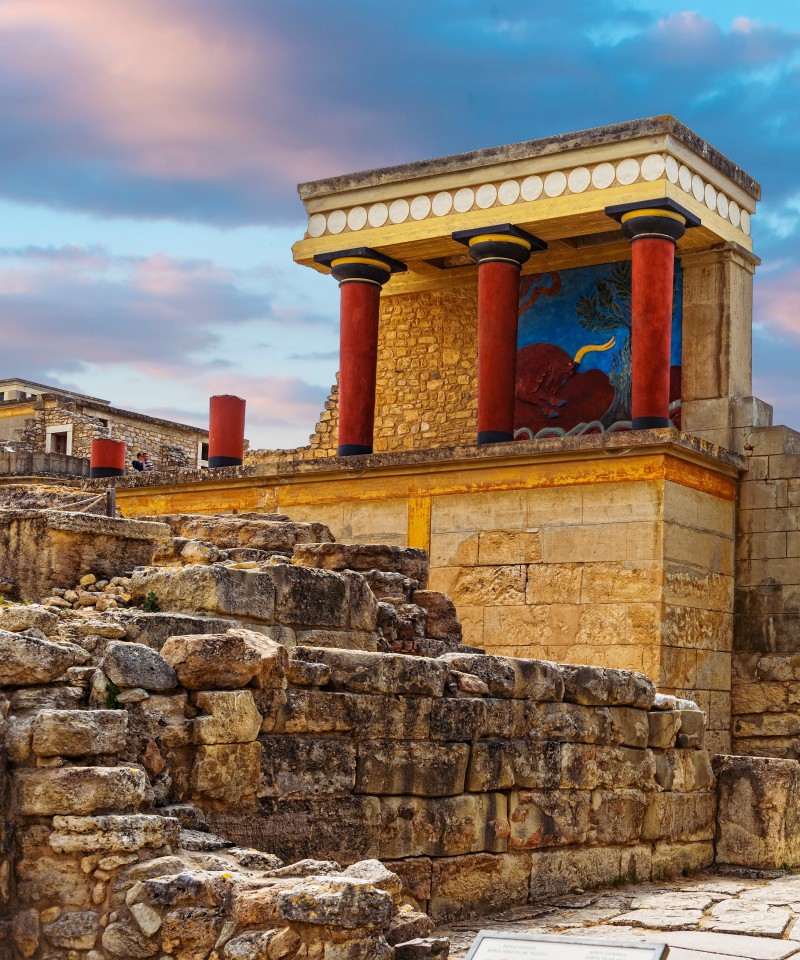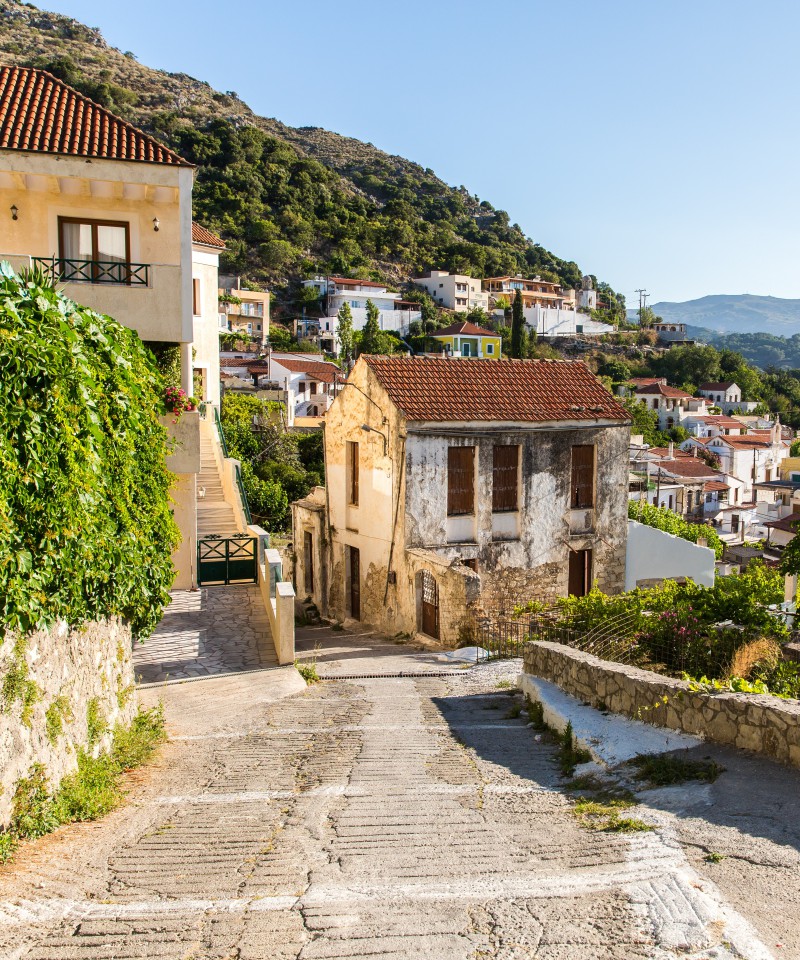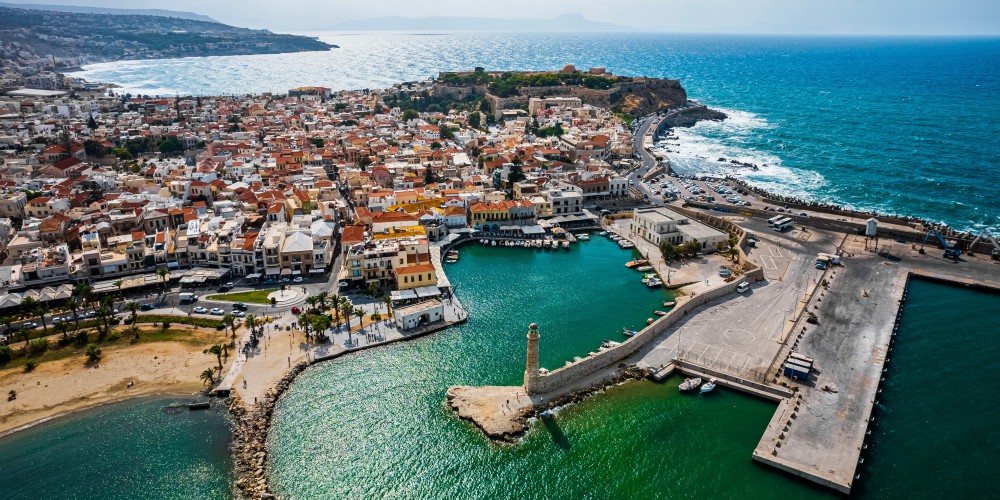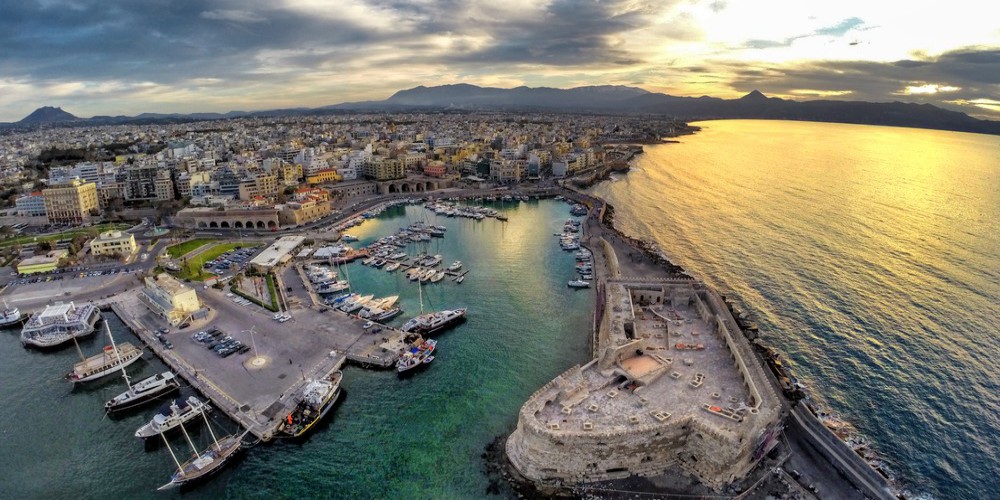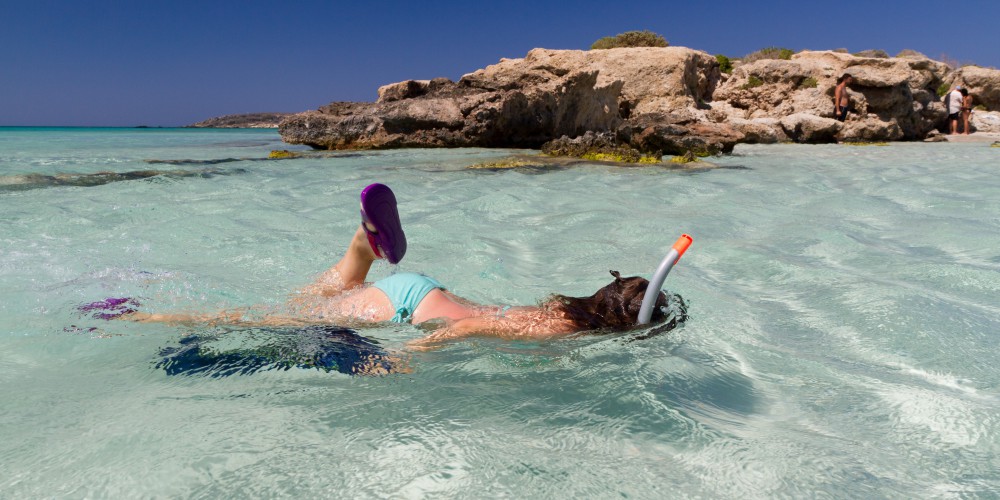
Top Archaeological Sites & Museums in Crete
Key Takeaways
- The Crete archaeological sites attract thousands of visitors each year.
- The local culture in Crete is steeped in history, with numerous significant archaeological sites that offer insights into the island's ancient civilizations.
- The Knossos Palace is one of the most prominent archaeological sites in Crete. It was the largest palatial center of the Minoan civilization, covering 20,000 m2.
- Other notable ancient sites in Crete include the ancient city of Eleftherna, the site of Zominthos, the Phaistos Palace, and the archaeological site of Malia.
Crete has been recognized as a true Greek island dazzler due to its arresting allure, with a long and breathtaking coastline that boasts beautiful beaches. Every year, thousands of visitors visit Crete and are enchanted with the beautiful landscape and rich culture.
The world-renowned Cretan cuisine, the age-old traditions, and the genuine hospitality the locals are known for are enough to make the island one of the most sought-after vacation destinations in the world.
A prominent aspect of the local culture is its long and rich history, which is evident by a large number of famous archaeological sites in Crete, each offering an original tale to tell.
Between the Hellenistic and Roman periods, Crete has an extensive history discovered through excavations, making the archaeological sites in Crete some of the most fascinating in the world. Several of the ancient ruins have survived for thousands of years, giving them unique beauty.
Archaeological Sites in Crete and Ancient Crete Ruins
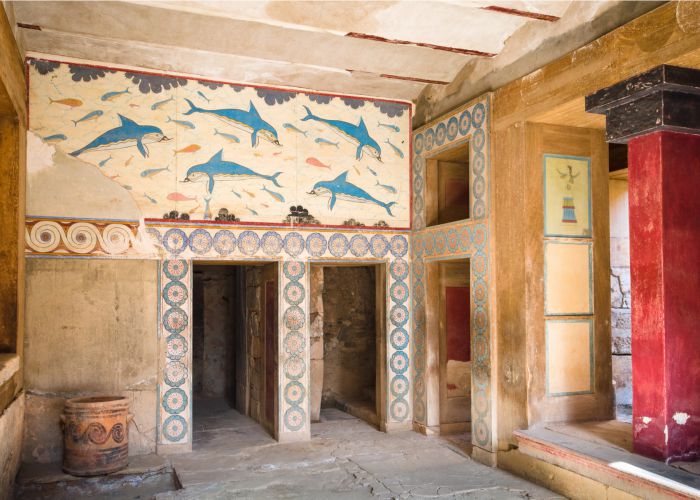 Knossos ruins - Minoan civilisation - credits: Georgios_Tsichlis/Shutterstock.com
Knossos ruins - Minoan civilisation - credits: Georgios_Tsichlis/Shutterstock.com
Knossos Palace
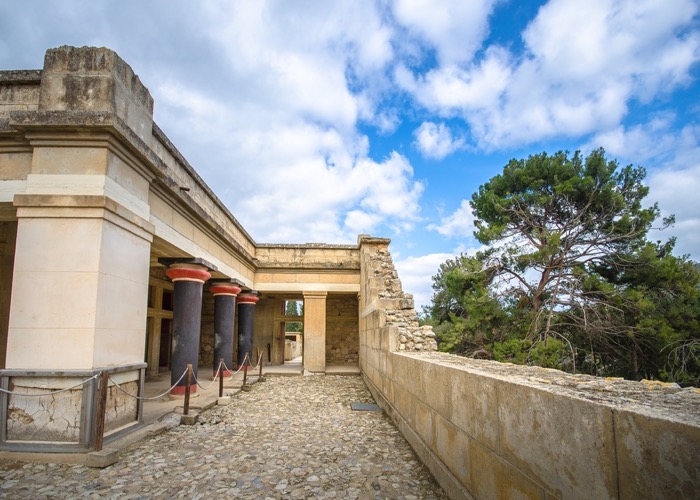 Knossos Palace - credits: Georgios Tsichlis/Shutterstock.com
Knossos Palace - credits: Georgios Tsichlis/Shutterstock.com
The most brilliant palatial center of Crete is the legendary Minoan palace of Knossos. It is the largest of all the power centers from the Minoan civilization, stretching across 20,000 m2, and one of the first sites you should visit when you arrive from Athens to Crete.
The Minoan palace was built on a hill in an area that was continuously inhabited from the Neolithic era to the pre-palatial years (7th - 3rd millennium BC). The first palace was built after 2000 BC and was destroyed by an earthquake around 1700 BC.
Immediately after, the second palace was built - larger, more luxurious, and with a labyrinthine layout.
The damage from an earthquake that occurred was repaired, and the palace continued to function until 1450 BC, when the great seismic disaster occurred, which leveled all the Minoan centers of Crete.
The palace was repaired and used during the first period of the 'Mycenaean occupation' of Crete when Achaean rulers installed themselves on the throne of Knossos Palace. The final destruction was due to fire.
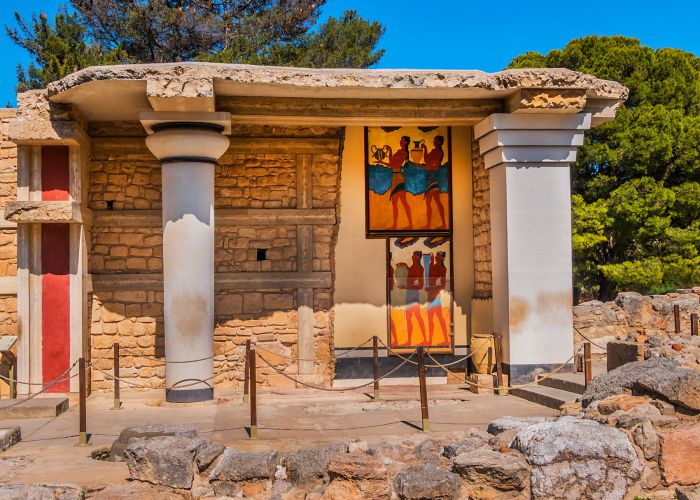 Knossos Palace ancient ruins - credits: Kiev.Victor/Shutterstock.com
Knossos Palace ancient ruins - credits: Kiev.Victor/Shutterstock.com
The palace included a large rectangular paved courtyard, around which four wings were developed and where the same number of corridors ended.
In the eastern wing were the apartments that have been interpreted as royal, the workshops, and a sanctuary. In the west wing, the 'throne room,' the central sanctuary, the treasury, and large storerooms, and on the second floor, large ceremonial halls and sanctuaries.
North and south were walled corridors leading out of the palace.
The paved courtyard to the west of the palace with the 'processional streets' was probably a ceremonial site. The palace was multi-storied, built with hewn structures, and decorated with colorful frescoes.
Some roofs were decorated with Minoan double horns. The water supply and drainage of the complex were done with clay pipes.
Around the palace, a rectangular theater, three circular granaries or storehouses, and roads leading to the harbor and the city that grew on a large area around.
Large buildings have been excavated from it, such as the 'Little Palace,' the 'Royal Palace,' the 'House of Frescoes,' the 'Caravan Serai,' the 'House of the High Priest' etc.
The city's cemeteries stretched all over the neighboring hills and included hundreds of vaulted and chambered tombs.
The excavation of Knossos yielded an extraordinarily large number of works of art, frescoes, sacred objects, vases, utensils, and valuable records of Linear A and B writing, which shed light on the centuries-old history of the site where the center of Europe's first great civilization developed.
The archaeological treasures are exhibited at the Archaeological Museum of Heraklion.
Ancient Eleftherna
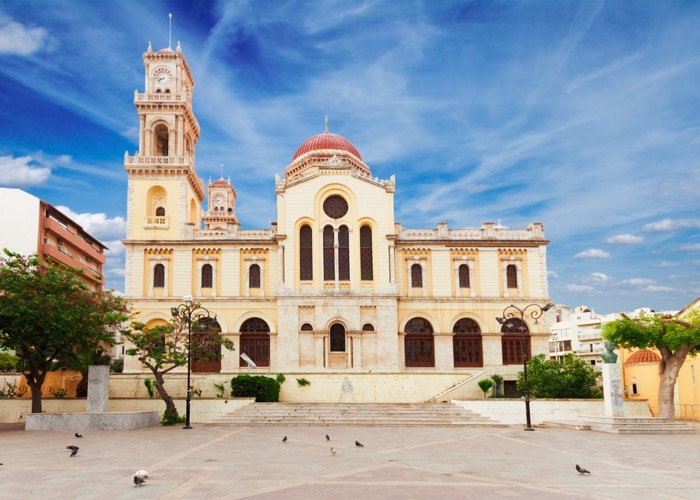 Saint Minas church - credits: Neirfy/Shutterstock.com
Saint Minas church - credits: Neirfy/Shutterstock.com
In the northwestern foothills of Mount Psiloritis -or Idi-at an altitude of approximately 380 m, and at a distance of 30 km south of Rethymnon, lies the ancient city of Eleftherna.
Today, archaeological ruins from various historical periods of the life of ancient Eleftherna are preserved.
In the 3rd century, Eleftherna fought against the Rhodians and their Knossian allies. When in 220 BC, the Cretan cities were fighting each other, Eleftherna sided with Knossos.
However, under siege by his opponents, he was forced to abandon this alliance. In 68 BC, when Metellus attacked Eleftherna, the city managed to resist the Roman siege for some time due to its fortified position but was finally captured after treachery.
The poet Linos, the philosopher Diogenes, the lyric poet Amitor, and the sculptor Timocharis came from the city of Eleftherna.
Excavation research was carried out at the archaeological site in 1929 by the English School of Archaeology under the direction of H. Payne and had a short duration.
Systematic excavations carried out since 1985 by the University of Crete brought to light important archaeological remains, which give the image of the ancient city, mainly from the Geometric to the early Byzantine times, without, however, missing the evidence of the continuous use of the area from the early Minoans up to the younger years.
The archaeological site of Eleftherna in Crete extends over a wide area, but the main nuclei of the ancient city are located on the hills of Nissi and Pyrgi, which belong to the settlements of Eleftherna and Ancient Eleftherna.
Today, on the eastern side of Pyrgi Hill, the main remains are the Hellenistic retaining walls, other ancient ruins of Roman buildings, and an early Christian basilica.
A post-Geometric - Archaic cemetery was found at the Standing Stone site. A Roman building phase has been covered under part of the cemetery. The ancient ruins of a Hellenistic quarter are located at Nisi.
On the eastern foothills of the Pyrgi hill, in the Katsivelos location, the ruins of an early Christian basilica of Michael the Archangel have been discovered, which dates, according to the founding inscription, to 430-450 AD. and was destroyed in the 7th c. A.D.
The basilica was partially founded on the ruins of a Hellenistic sanctuary, which was also used during imperial times.
On a summit plateau in the northern part of the Pyrgi Hill, where the timeless core of the ancient city is located, the excavation revealed building remains, which date mainly to the Roman and early Christian times.
In addition to the remains uncovered during the archaeological investigations, several sites have been identified in the area where visible archaeological remains or individual monuments are preserved.
Among them stands out a part of a fortified tower at the top of the Pyrgi Hill, used from the Hellenistic to Byzantine times, as well as a Hellenistic bridge north of the Pyrgi Hill.
Zominthos
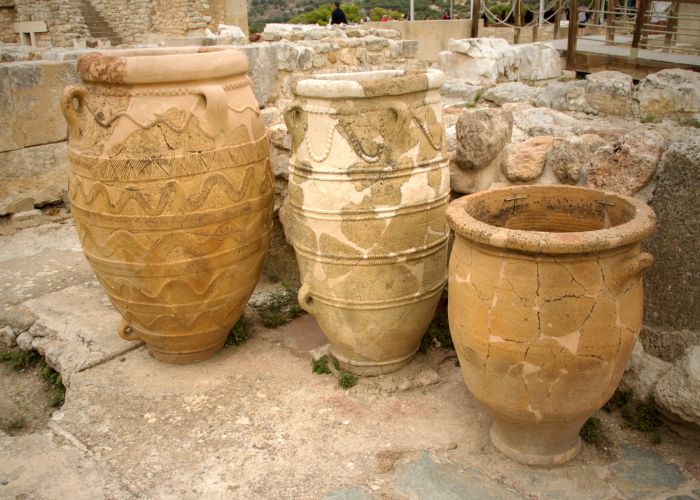 Antique Greek 'pithos' Minoan clay vases - credits: SaskiaAcht shutterstock.com
Antique Greek 'pithos' Minoan clay vases - credits: SaskiaAcht shutterstock.com
Even for archaeological research, Psiloritis Mountain is inexhaustible in surprises.
A pre-Greek word that has stood the test of time, the toponym Zominthos, led to the identification of a unique ancient site. Just a few years ago, a huge Minoan building was pointed out in this place, surrounded by a settlement with a cemetery and a large archaeological site that awaits its future excavation.
Every hiker on the north-eastern slope of Psiloritis heading to Ideo Andros, either from the ancient road of Knossos-Ideo Andros or from the current carriage road through Anogeia, has to stop to rest at the archaeological site of Zominthos.
There, they can drink some of the abundant spring water, light a candle in the small church of Agia Marina, or just be soothed by the peaceful beauty of the verdant little plain.
In this magical place, on a humble outcrop of land, the so-called central building of the archaeological site Zominthos is built, a two-story former building decorated with frescoes, the walls of the rooms of which can be seen on the surface, among the trees. In addition, two or three rooms that have been excavated are preserved at a height of over two meters.
 Kri Kri wild goat - credits: irakite/Shutterstock.com
Kri Kri wild goat - credits: irakite/Shutterstock.com
One of them was a ceramics workshop with all the tools and materials of the 16th-century potter in their place.
The operation of a permanent craft installation at an altitude of 1,200 m in Psiloritis suggests that the settlement of the Minoan civilization in Zominthos was not only due to the reason of serving the pilgrims of Idaios Andros.
The place's wealth could not remain unexploited even in the Minoan years.
{awloadcontentid 313}
It was not only the timber and herbs of Psiloritis, but even the sheep.
The dozens of well-known shepherds of the Linear B tablets would certainly only have their winter quarters in Knossos, and naturally, the summer pastures would be in the mountains.
It is not by chance that a Venetian cheese factory and a later cheese factory were installed in Zominthos, which have recently been restored.
The project to highlight the archaeological sites in Psiloritis, even with the restoration of dozens of sites, does not aim so much at excavations as primarily at upgrading the natural and built environment, saving the eternal wealth of the mountains.
Phaistos Palace
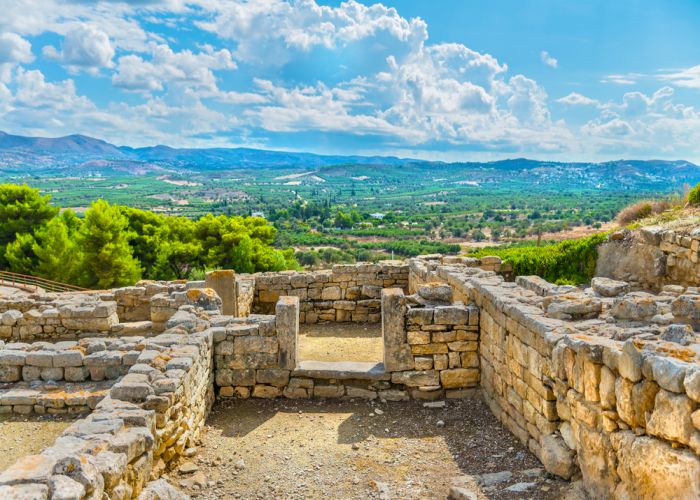 Phaistos - credits: Luxerendering/Shutterstock.com
Phaistos - credits: Luxerendering/Shutterstock.com
The palace of Phaistos, one of the most important archaeological sites in Crete, one of the most impressive Minoan palaces, and the second in size after that of Knossos, stretching across around about 18,000 m2, is built on a hill at the western end of the largest and richest Mesara plain.
From this point, the local lord-king controlled not only the goods of the plain but also the exit to the sea and the ports of the Gulf of Messara.
This low hill is part of a row of small hills that extend toward the east. Between the massif of Ida to the north and the Asterousia to the south, they reach the sea and close the plain to the west. According to Greek mythology, Phaistos was ruled by the dynasty of Rhadamanthys, son of Zeus and brother of Minos.
The royal villa of Phaistos is considered a textbook example of a typical Minoan palace due to its excellent architectural composition and flawless construction.
The first palace of Phaistos was built at the beginning of the 2nd millennium BC, on top of the lowest hill, which was leveled and shaped accordingly.
The life of the first Minoan palace lasted approximately three centuries, as around 1700 BC it was destroyed by a great fire.
A new, grander palace was built on top of the ruins, which was destroyed, like the other centers of the Minoan period, in the middle of the 15th century BC.
Most ruins that the visitor sees today belong to it.
 Old Venetian harbor of Chania - credits: Patryk_Kosmider/Depositphotos.com
Old Venetian harbor of Chania - credits: Patryk_Kosmider/Depositphotos.com
Inhabitation in Phaistos dates back to the Neolithic period, as evidenced by the foundations of Neolithic houses, tools, figurines, and potsherds uncovered under the palace during excavations.
The Neolithic settlement must have spread over the top of the hill and its southwestern slope. In the middle of the 3rd millennium BC, the use of metals began, a fact that favors the city's development.
The development continued until the establishment and consolidation of the Minoan palaces. At the beginning of the 2nd millennium, power passed into the hands of kings, who established large palaces.
The Minoan city developed around the palatial center on a large area.
Phaistos was the seat of the king, who controlled not only the rich plain of Messara but also the settlements in the wider area and the exit to the sea and the ports of the Gulf of Messara.
After the destruction of the palace, the city of Phaistos continued to be inhabited in the Mycenaean years and the Geometric era.
Malia Archaeological Site
 Balos, Crete - credits: natalyphotography/Shutterstock.com
Balos, Crete - credits: natalyphotography/Shutterstock.com
The archaeological site of Malia is located 3 kilometers east of the homonymous town.
In this area, there was an important city with a Minion palace, similar in size to those of Knossos and Phaistos but less imposing.
The ancient name of the city is not known, while today's name, 'Malia,' comes from the word 'Omalia,' which indicates the smoothness of the ground.
Excavations at the archaeological site began in 1915. These excavations did not bring findings such as wall paintings, vases, etc., as in Knossos and Phaistos.
This suggests the provincial character of the Minoan palace.
Sarpedon, brother of King Minos and Rhodamanthys, reigned in the palace of Malia. The city minted its coins on which the head of Athena was depicted on one side and two dolphins on the other.
Among the most important findings that have been found is the gold jewelry with the two bees, which can be admired at the Heraklion Archaeological Museum.
The first royal villa was built around 1900 BC and had an area of 8,800 square meters. In 1700 BC, it was destroyed, and a new one is being built, which in turn was destroyed around 1450 BC.
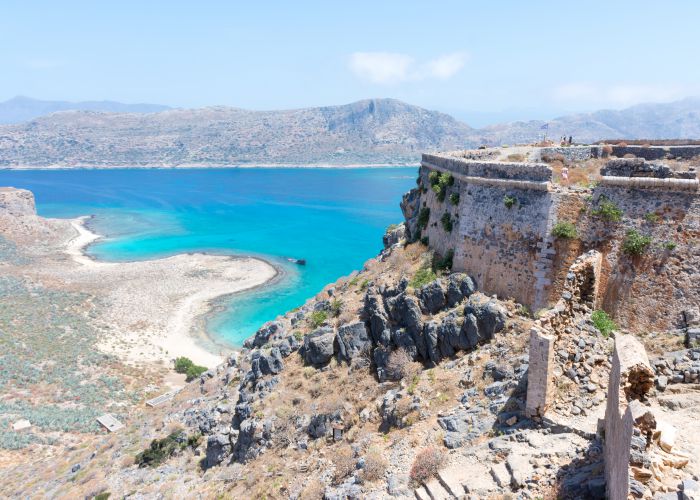 Venetian Fortress of Gramvousa - credits: KVN1777/Shutterstock.com
Venetian Fortress of Gramvousa - credits: KVN1777/Shutterstock.com
The palace inside the important archaeological site is two-storied and has a central court with an oblong shape. It also has four wings and five entrances.
The most important part of the palace is its western side, which is also the largest.
In the palace, as in the palaces of Knossos and Phaistos, circular storerooms in which many vases and jars were found, royal rooms, workshops where copper, ivory, etc. were processed, a weapons room where the famous royal scepter, an altar which was in the central court of the palace.
From the northern gate of the palace, there was a road that led to a small bay that the Minoans used as a port. Around the palace were various districts that complemented the Minoan city.
Today several have come to light, and one of them houses various findings, making Phaistos one of the top archaeological sites in Crete.
Museums
Heraklion Archaeological Museum
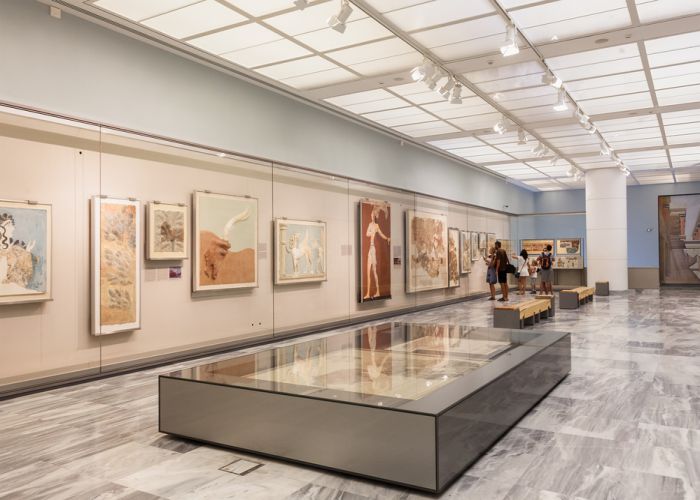 Heraklion Archaeological Museum - credits: _Anna_Pakutina/Shutterstock.com
Heraklion Archaeological Museum - credits: _Anna_Pakutina/Shutterstock.com
The Archaeological Museum of Heraklion is one of the largest and most important museums in Greece and one of the most important in Europe.
Its exhibits include representative specimens from all periods of Cretan prehistory and history, spanning approximately 5,500 years, from the Neolithic to Roman times.
That being said, the unique masterpieces of Minoan art, which one can admire in its entire evolution, occupy a dominant position in its collections.
The collection of Minoan antiquities is the most important in the world, and the museum is rightly considered the museum par excellence of Minoan culture.
The building, where it is housed, is located in the center of the city and was built between the years 1937 and 1940, according to the plans of the architect Patroklos Karatinos.
In the same place during the Venetian rule was the Catholic monastery of Saint Francis, which was destroyed by an earthquake in 1856, and its ruins are visible today behind the museum garden.
The museum building is an important example of the modern architectural movement in Greece, awarded Bauhaus praise in the interwar period.
The colors and construction materials, as well as the colorful veined marbles, refer to the mural imitations of ortho-marbling of Minoan buildings.
The building is two stories high and has extensive exhibition spaces, an audio-visual media room, and workshops.
The museum also has a changing room, a casting shop leased on behalf of the Archaeological Resources Fund, and a cafe with seating in the garden.
The Archaeological Museum of Heraklion has been set up as a Special Regional Service of the Ministry of Culture and has as its purpose the acquisition, acceptance, safekeeping, maintenance, recording, documentation, research, study, publication, and above all,
exhibition and presentation of objects dating from the remotest times of prehistoric times to the post-Roman period.
It organizes periodical exhibitions, participates in exhibitions that tour Greece and abroad, collaborates with other scientific and research organizations, and hosts a variety of other cultural activities.
It is a must when visiting Crete or staying in one of the amazing hotels in Heraklion, the capital city of the island!
Archaeological Museum of Agios Nikolaos
 Fishing boats in Heraklion - credits: pamuk/Shutterstock.com
Fishing boats in Heraklion - credits: pamuk/Shutterstock.com
The Archaeological Museum of Agios Nikolaos was created to exhibit archaeological treasures found in archaeological sites in eastern Crete that, until then, were transferred to the Heraklion Museum.
The museum's exhibition does not have its definitive form but covers a huge period of time from the Neolithic Age to the end of the Greco-Roman period.
Visitors can follow the timeless evolution of art in the area through representative samples of various rhythms and eras.
The building that hosts the Archaeological Museum of Agios Nikolaos is rectangular, with eight exhibition rooms arranged in a circle around a central rectangle and paved atrium.
In front of it opens a covered courtyard that leads to the maintenance laboratory and to a garden that surrounds the main building.
The exhibition halls open in front of the main entrance. Visitors can proceed to the left and, following a clockwise course, observe the exhibits according to excavation sets and in chronological order.
 View of Heraklion harbor from Koule - credits: Georgios Tsichlis/Shutterstock.com
View of Heraklion harbor from Koule - credits: Georgios Tsichlis/Shutterstock.com
In the first room, offerings found in 1971 in the seaside cemetery of Agia Fotia are exhibited.
This cemetery was the largest number of tombs in prehistoric Crete and one of the largest in Greece, had at least 260 tombs with over 1,600 vessels, some bronze manuals, and many obsidian blades.
The vases made without the help of a pottery wheel follow various shapes and bear witness to intra-Cretan relations and influences, as well as with the Cyclades.
The Cycladic influences, in fact, are so strong that we can speak of Cretan Cycladic culture.
In the second room, another famous younger group of pottery from the important Proto-Minoan settlement of Fournos Korifi near the village of Myrtos Ierapetras is exhibited.
The most famous object of the museum, 'the goddess of Myrtle,' belongs to it. It is an excellent spinal vessel in the form of a stylized goddess with a very small head a tall, slender neck, and a bell-shaped body.
In the past, periodic exhibitions have been hosted in the museum, such as: 'Lasithi 5,000 years of artistic expression: Nikos Sotiriadis, 1997 A.D. mask-figures,' and 'European Cultural Heritage Days: The Immortal Water.'
Historical Museum of Crete
 Crete tomb in Mycenae - credits: PavleMarjanovic/Shutterstock.com
Crete tomb in Mycenae - credits: PavleMarjanovic/Shutterstock.com
The Historical Museum of Crete was founded in 1953 by the Society of Cretan Historical Studies.
For the housing of the Museum, a neoclassical building dating back to 1903 was granted by the A. & M. Kalokairinou Foundations, by the will of the testator.
The aim of EKIM, which founded and still operates the Historical Museum of Crete, was and is to preserve and promote the cultural heritage of Crete from the early Byzantine times to the modern era.
This goal was achieved gradually, with collections, purchases, and donations of objects, as well as with the deposit of objects by the Ministry of Culture.
The Historical Museum exuded a pioneering spirit from the beginning.
The successive expansions of the Museum and the recent re-exhibitions with modern museological concepts and electronic applications contributed to the creation of a living museum, friendly for the visitor, with modern data.
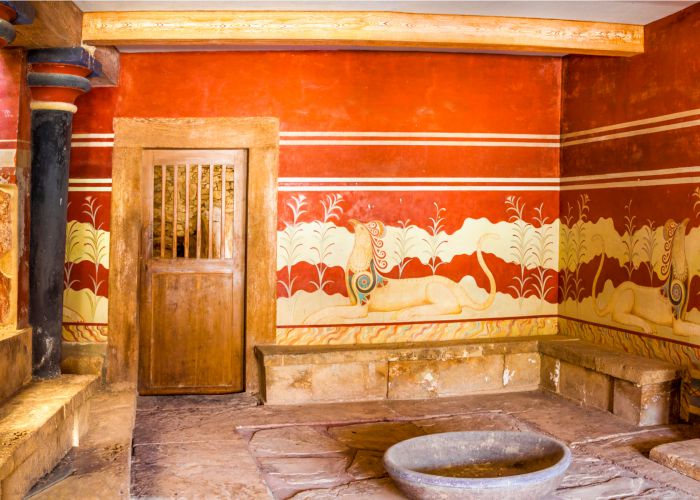 Knossos Palace, the kings' chamber - credits: Shutterstock.com
Knossos Palace, the kings' chamber - credits: Shutterstock.com
Today, the museum offers a complex picture of the History and Art of Crete from the first Christian times to the 20th century.
The periodical exhibitions cover a wide spectrum, from Byzantine to modern art, highlighting the leading literary figures of Greece and the presentation of major historical events from the end of the 19th century up to the Second World War.
Accordingly, the ever-enriching educational programs offered free of charge are a creative source of learning about the Museum's Permanent Collections and Periodical Exhibitions.
Lectures, scientific symposia, film screenings, and book presentations held in the museum's amphitheater complement its function, making it an extroverted, multifaceted cultural organization.
The HMC Library, with rare publications, magazines, archives of local newspapers, and a rich set of historical archives and photographic material, is addressed not only to researchers but also to the general public.
Arkadiou Monastery Museum
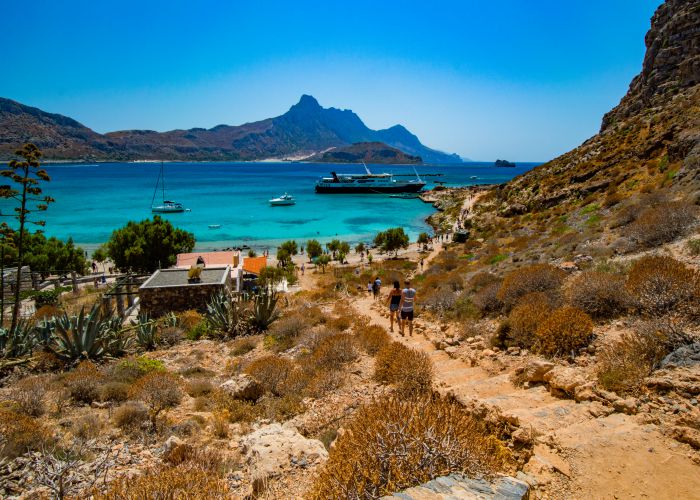 Gramvousa Island, Crete - credits: N.B._photo/Shutterstock.com
Gramvousa Island, Crete - credits: N.B._photo/Shutterstock.com
Arkadiou Monastery is located near the village of Amnatos, 23 kilometers east of Rethymno, and is built at an altitude of 500m on a verdant plateau with olive groves and pine trees.
Arkadiou Monastery is perhaps the most historic monastery of Crete, which became a symbol of the Candle Wars, as the tragic holocaust of 1866 took place in Arkadi with the explosion of the wine cellar where the revolutionaries kept the gunpowder.
The history of the Cretan Games in Arkadi and the contribution of the Monastery to them are witnessed by the objects exhibited in the Arkadi Monastery Museum, located inside the monastery.
The museum was founded in 1932 under the care of the then-bishop of Rethymno and Avlopotamos, Timotheus Veneris.
The museum houses objects of a historical and religious nature, including in its collections Cretan icons, church books and manuscripts, church relics, and vestments.
Among the collections of the Monastery, the portals with the representations of the Annunciation and the Apostles Peter and Paul (15th century), Saint John the Forerunner (end of the 16th century), Christ enthroned (1631), Saint George Kefalophorus (17th century) stand out.
Among the exhibits of the Museum, the visitor will have the opportunity to see the only part of the temple that was saved from its burning.
Natural History Museum of Crete
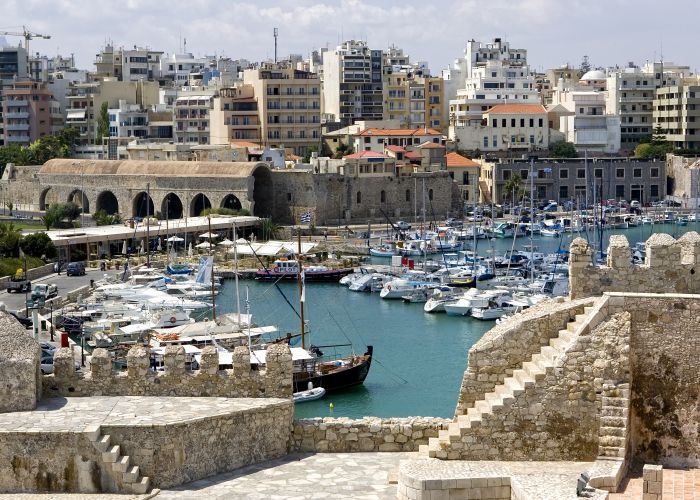 Heraklion overview - credits: vkph64/Depositphotos.com
Heraklion overview - credits: vkph64/Depositphotos.com
Straying from the theme of ancient history but equally as important is the Natural History Museum of Crete.
The Museum of Natural History of Crete (MNHC) was founded in 1980 and focuses on basic and applied research of the biodiversity of the Aegean and the eastern Mediterranean, the structure of ecosystems with an emphasis on island ecosystems, coastal ecosystems, wetlands, mountain ecosystems, the evolution, classification, and ecology of specific organisms with an emphasis on endemic and endangered species of plants and animals, of the geological structure and evolution of the eastern Mediterranean, and phylogeny, systematics, and genetic structure, with molecular techniques.
Through its participation in more than 90 national or European programs, MNHC, and its academics and researchers have contributed to hundreds of publications in international scientific journals and proceedings at international and national conferences.
At the same time, the MNHC has implemented dozens of environmental education programs for various groups (students, teachers, special groups, general public) while it also participates in specialized research educational programs.
Visiting this museum is one of the best things to do in Crete!
 Samaria Gorge - credits: Efstathios_Chatzistathis/Shutterstock.com
Samaria Gorge - credits: Efstathios_Chatzistathis/Shutterstock.com
The MNHC covers all the activities of a complete and modern museum, maintaining and developing collections, while it has designed, shaped, and organized many periodic exhibitions inside and outside Greece.
In addition, it develops an extensive publishing project, maintains a photographic archive and a fully updated library, and houses an embalming and exhibits laboratory.
All the above databases support both the undergraduate and postgraduate studies of the Biology Department of the University of Crete, as well as the basic and applied research of the academic community, as well as the information needs of services, agencies, and local communities.
It must be noted that MNHC received an award from the Academy of Athens for its entire scientific work (2012), while for the quality of its exhibition space (which receives more than 50,000 visitors annually) and the services provided there, it has been distinguished since 2013 and every year with an award of excellence from Tripadvisor.
Final Thoughts
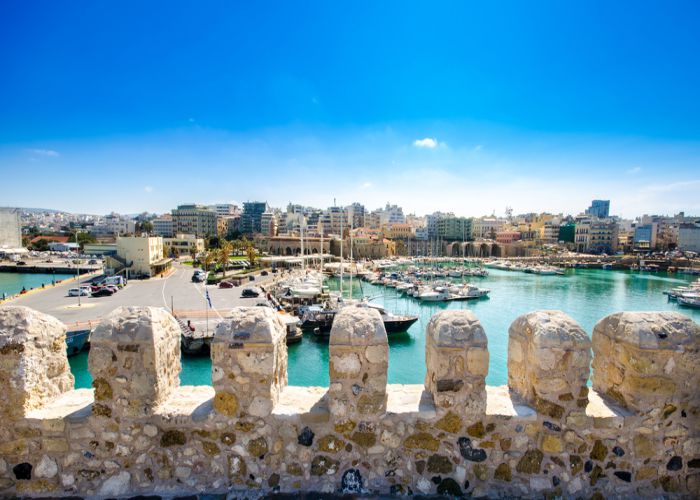 Heraklion harbour - credits: Georgios Tsichlis/Shutterstock.com
Heraklion harbour - credits: Georgios Tsichlis/Shutterstock.com
The archaeological sites and museums in Crete are many and captivating.
Dating back to the Minoan period, from Minoan palaces to striking theaters and artful courtyards, there are endless options for those who want to dive into Cretan history and culture.
Now you have all the information you need to decide which among the numerous museums and archaeological sites in Crete you will visit.
Happy exploring one of the Greek islands that will leave you in awe!






